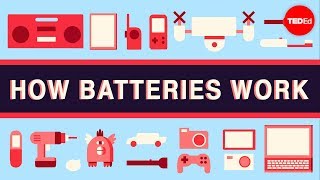(单词翻译:单击)
You probably know the feeling.
你或许知道那种感觉。
Your phone utters its final plaintive 'bleep' and cuts out in the middle of your call.
你的手机发出最后的、可悲的哔哔声,然后中断了你的通话。
In that moment, you may feel more like throwing your battery across the room than singing its praises,
在那个瞬间,比起唱赞歌,你更想把你的电池怒摔到房间的另一边,
but batteries are a triumph of science.
不过电池可是科学届的一项巨大成就。
They allow smartphones and other technologies to exist without anchoring us to an infernal tangle of power cables.
它们使智能手机和其他科技在我们不需要随时携带恶魔般恼人的电源线的情况下存在。
Yet even the best batteries will diminish daily, slowly losing capacity until they finally die.
即使如此,连最好的电池也会逐日消耗,慢慢的失去它的容电量,直到最后再也无法供电。
So why does this happen, and how do our batteries even store so much charge in the first place?
这为什么会发生呢?还有我们的电池最初是如何存放如此多电荷的呢?
It all started in the 1780s with two Italian scientists, Luigi Galvani and Alessandro Volta, and a frog.
这一切都始于18世纪80年代的两名意大利科学家,路易吉·伽伐尼和亚历山德罗·伏特,还有一只青蛙。
Legend has it that as Galvani was studying a frog's leg,
根据传说,伽伐尼在研究青蛙腿时,
he brushed a metal instrument up against one of its nerves, making the leg muscles jerk.
用一个金属的装置逆向刷理神经,使青蛙腿发生抖动。
Galvani called this animal electricity, believing that a type of electricity was stored in the very stuff of life.
伽伐尼把这叫做动物电,他认为这是一种储存在生命体某个特殊部位的电。
But Volta disagreed, arguing that it was the metal itself that made the leg twitch.
但是伏特不同意,他认为是金属本身导致了腿的颤抖。
The debate was eventually settled with Volta's groundbreaking experiment.
这个争论最终以伏特的一个创新实验宣告结束。
He tested his idea with a stack of alternating layers of zinc and copper,
他使用了一摞锌铜交互的金属层,
separated by paper or cloth soaked in a salt water solution.
每两层间都由浸泡过盐溶液的纸或布分开,以此来验证他的想法。
What happened in Volta's cell is something chemists now call oxidation and reduction.
伏特的电池中发生的就是化学家们如今称作氧化和还原的反应。
The zinc oxidizes, which means it loses electrons,
锌被氧化了,这意味着它失去了电子,
which are, in turn, gained by the ions in the water in a process called reduction, producing hydrogen gas.
这些电子被水中的离子通过还原反应吸走了,从而产生了氢气。
Volta would have been shocked to learn that last bit.
伏特如果得知最后这一点的话一定会很震惊。
He thought the reaction was happening in the copper, rather than the solution.
他以为反应是在铜层发生的,而不是在溶液中。
None the less, we honor Volta's discovery today by naming our standard unit of electric potential 'the volt.'
尽管如此,我们如今仍然把电势的标准单位命名为伏特,以此表彰他的贡献。

This oxidation-reduction cycle creates a flow of electrons between two substances
这个氧化还原周期创造了两个物质间的电子流动,
and if you hook a lightbulb or vacuum cleaner up between the two, you'll give it power.
如果你将一个灯泡或吸尘器放在中间,它就会为得到电。
Since the 1700s, scientists have improved on Volta's design.
18世纪后,科学家们改进了伏特的设计。
They've replaced the chemical solution with dry cells filled with chemical paste, but the principle is the same.
他们用充满化学粘浆的干电池取代了化学溶液,但工作原理是一样的。
A metal oxidizes, sending electrons to do some work before they are regained by a substance being reduced.
一种金属被氧化,释放电子并做功,然后这些电子会进入被还原的物质中。
But any battery has a finite supply of metal, and once most of it has oxidized, the battery dies.
但是任何电池的金属补给都是有限的,一旦金属的大部分被氧化,电池就无法工作了。
So rechargeable batteries give us a temporary solution to this problem by making the oxidation-reduction process reversible.
所以充电电池通过可逆转的氧化还原过程暂时解决了这个问题。
Electrons can flow back in the opposite direction with the application of electricity.
电子可以通过充电作用从而发生逆向流动。
Plugging in a charger draws the electricity from a wall outlet that drives the reaction to regenerate the metal,
接通充电器能够引入墙壁插座中的电流,这一反应可以恢复金属的供电能力,
making more electrons available for oxidation the next time you need them.
当你下次需要的时候会有更多电子参与氧化反应。
But even rechargeable batteries don't last forever.
但是充电电池也不可能永久持续供电。
Over time, the repetition of this process causes imperfections and irregularities in the metal's surface that prevent it from oxidizing properly.
随着使用时间增加,过程的反复会导致金属表面发生消耗和不规则缺损,无法进行正常的氧化反应。
The electrons are no longer available to flow through a circuit and the battery dies.
电子再也无法形成电流通路,电池也就失去了供电功能。
Some everyday rechargeable batteries will die after only hundreds of discharge-recharge cycles,
有些日常的充电电池只经过几百个充电周期就会坏掉,
while newer, advanced batteries can survive and function for thousands.
但是高级一些的电池可以存活并正常工作长达几千个周期。
Batteries of the future may be light, thin sheets
未来的电池可能会变成很轻的薄片,
that operate on the principles of quantum physics and last for hundreds of thousands of charge cycles.
依据量子物理的原理工作,可以完成几十万次的充电周期。
But until scientists find a way to take advantage of motion to recharge your cell battery,
但是直到科学们找到通过运动充电的方法,
like cars do, or fit solar panels somewhere on your device, plugging your charger into the wall,
像汽车的充电电池那样,或者将太阳能板安装到你的移动设备上,将充电器插入墙壁,
rather than expending one battery to charge another is your best bet to forestall that fatal 'bleep.'
而非消耗一个电池去为另一个装置充电,才是最好的预防致命的哔哔声的方法。


